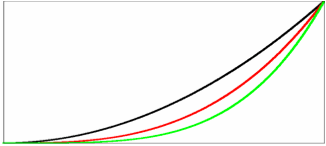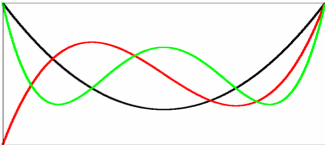

|
| Sloppiness comes from parameters which affect the predictions in similar ways. Here the monomials x3, x4, and x5 all are flat near zero, and increase smoothly near one. We can trade the coefficient a4 for a suitable combination of a3 and a5, and get almost exactly the same final function. |
Multiparameter models are usually sloppy - their parameters can vary over huge ranges without changing the fits to data very much. Where does this sloppiness come from? We provide three answers to this question, all really the same answer in disguise.
Consider the standard problem of fitting polynomials to data. Our model is a sum of monomials xn, with coefficients an:
1. Sloppiness comes from having groups of parameters whose effects can be traded for one another.
Indeed, if we are fitting a continuous function in the range between zero and one, we can explicitly calculate the Hessian matrix whose range of eigenvalues we use to decide whether the system is sloppy. This Hessian is the Hilbert matrix:
| Hij = 1/(i+j+1) = |
|

|
| Changing the parameters can remove the sloppiness. When fitting polynomials to data, one is told to vary not the monomial coefficients an, but the coefficients bn of a suitable class of orthogonal polynomials: here the shifted Legendre polynomials Ln. Here are plotted L3, L4, and L5. By design, these polynomials can't be traded for one another. The same polynomial fit to the same data, expressed in terms of new variables bn, is not sloppy. |
Those readers who actually have fit polynomials to data will remember, though, that one doesn't usually calculate the monomial coefficients an. Instead, one fits to a sum of orthogonal polynomials
2. Sloppiness comes from the way we choose the variables in our theory.
Notice that in the case of fitting polynomials, we often don't think that
the monomial coefficients are very important: the b variables are
almost as natural as the a variables. But in a biological model
or an engineering system, the variables we use are usually natural and sensible,
and using strange combinations of variables just to avoid sloppiness will
usually not make scientific sense.
Why did changing from the monomial coefficients an
to the orthogonal polynomial coefficients bn make
such a big difference? Unlike many familiar transformations, this
change is not just a rotation (in six-dimensional function space); it
is instead a very skewed, shearing kind of transformation (figure at left).
The meaning of "perpendicular" in parameter space is subtle: most
scientifically natural choices for parameters are sloppy for this reason.
3. Sloppiness comes a severe skewness between the scientifically natural "bare"
parameters and the parameters naturally governing the model behavior.
Can we understand the key properties of sloppy models mathematically? See
Why sloppiness? The Sloppy
Universality Class
James P. Sethna, sethna@lassp.cornell.edu; This work supported by the Division of Materials Research of the U.S. National Science Foundation, through grant DMR-070167.
![]() Statistical Mechanics: Entropy, Order Parameters, and Complexity,
now available at
Oxford University Press
(USA,
Europe).
Statistical Mechanics: Entropy, Order Parameters, and Complexity,
now available at
Oxford University Press
(USA,
Europe).